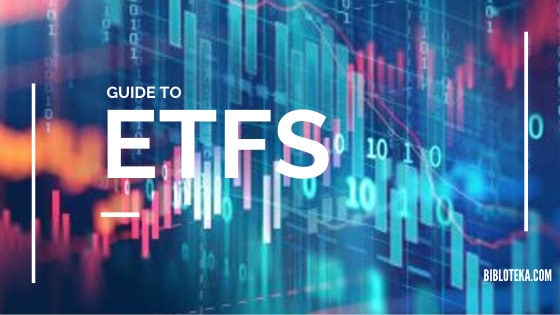What is an ETF?
Exchange-traded funds (ETFs) are collections of different securities, providing investors with the means to diversify their holdings with one purchase. ETFs trade as individual stocks and as securities, you can buy and sell ETF shares at any point during the trading day at the current market price.
How do ETFs Work?
Exchange-traded funds (ETFs) are securities that typically track the stock index or the sector. You can also get ETFs that track commodities, bonds, or a range of assets. ETFs are traded on the stock market when you purchase an ETF, you purchase shares in a portfolio that monitors the yield and return of the corresponding index or asset.
Like mutual funds, ETFs don’t need the active management of a financial advisor to help them produce higher returns than the average commodity traded on the stock market, because they are not built to beat the market.
Instead, ETFs are primarily structured to monitor, track, and generate returns on the basis of the overall performance of a particular stock or bond sector or of an entire market, such as the S&P 500.
Examples of ETFs
SPY was the first ETF to be listed in the United States and was structured to broadly suit the price and yield performance of the S&P 500 Index. It is the largest ETF of its kind, with over $250 billion in assets under management.
As with all investments, higher risk can equal higher returns. An ETF like SPY spreads the risk to 500 firms. The Invesco QQQ Trust (QQQ) spreads risk among fewer companies — the NASDAQ 100—and thus generates the highest returns among large-capitalization ETFs. The expense ratio of QQQ is marginally higher than that of other indexed ETFs, but its concentration of assets into stocks of very few companies could be more troubling.
QQQ holds more than 30% of its assets in Microsoft, Amazon, and Apple. Rather than a smaller portion of the market, Vanguard Total Stock Market (VTI) takes a wider view of the market by monitoring the CRSP U.S. Total Market Index of more than 3,600 companies of all sizes and industries. But with that far more expansive scope, VTI held pace with the narrower indexes, remained optimistic for 2018, and retained an equally low expense ratio.
Different Types of ETFs
Below are some common types of ETFs — just note that such categories aren’t mutually exclusive. For example, an ETF stock may also be index-based, and vice versa. Such ETFs are not classified by the type of management (passive or active), but rather by the type of investment kept within the ETF.
1.Stock ETFs
Which include stocks and are typically intended for long-term growth. Although typically less risky than individual stocks, they have slightly more risk than some of the others listed here, such as bond ETFs.
2.Commodity ETFs
Commodities are raw goods that can be bought or sold, such as gold, coffee, and crude oil. Commodity ETFs allow you to bundle these securities into one single investment. For commodity ETFs, it’s especially important to know what’s inside them — do you own a product in the fund’s physical store or own shares in companies that produce transport and store these goods? Will the ETF contain futures contracts? Through the eyes of the IRS, is the product considered “collectible?” Such factors may have significant tax consequences and varying levels of risk.
3.Bond ETFs
Like individual bonds, there is no maturity date for bond ETFs and the most common use for them is to generate regular cash payments to the investor. These payments are focused on the interest generated by the individual bonds within the fund. Bond ETFs can be a good, low-risk addition to stock ETFs.
4.International ETFs
Foreign stocks are widely recommended for the development of a diverse portfolio, along with U.S. stocks and bonds. International ETFs are a convenient way to find such foreign investments — and usually less risky. These ETFs can include investments in different countries or country blocs.
5.Sector ETFs
The U.S. stock market is divided into 11 sectors, each of which is made up of companies operating within that sector. Sector ETFs provide a means of investing in specific companies within those sectors, such as health care, financial or industrial sectors. These can be particularly useful for investors to track business cycles, as some sectors tend to perform better during expansion periods, others better during contraction periods. They often carry a higher risk than large-scale ETFs.
ETFs Features
ETFs have many features which made it one of the best types of investments.
1.Flexibility
As flexible as single stocks, ETFs can be traded during trading hours, while subscription and redemption of mutual funds usually take several days.
2.Simplicity
An ETF invests in a basket of stocks or bonds or other securities, providing simple access to a certain type of assets.
3.Transparency
ETFs usually track a benchmark index with a transparent index methodology. The actual holdings of the ETF shall be published on a daily basis. The real-time intraday net asset value (NAV) of the ETF per share is also published as a trading reference.
4.Cost-efficiency
ETFs generally charge comparatively lower management fees (from 0.1% to 1%) than traditional mutual funds.
In contrast to mutual funds, except for the minimum fees charged by exchanges and brokers, no subscription and redemption fees are charged in addition to the management fees.
5.Diversity
Compared to a single-stock investment, the ETF typically tracks a certain index made up of a basket of stocks, thus increasing the diversity of its portfolio.
With more and more ETFs tracking different types of indices listed on the Hong Kong Stock Exchange, different investment requirements can be met.
6.Leverage & Inverse ETFs
The ETF uses financial derivatives and debt to amplify the returns of the underlying index.
While the traditional ETF typically tracks securities in its underlying index on a one-to-one basis, the leveraged ETF may aim at a ratio of 2:1 or 3:1.
Disadvantages of ETFs
1.Convenience
The ease of buying/selling an ETF means that you might be able to sell an ETF if you later believed that you should have kept it. This disadvantage will, of course, be avoided by solid investment discipline.
2.Market Spread
If you purchase a rare ETF, the spread of purchase/ask may be somewhat significant. This can be avoided by investing in major ETFs.
3. Index Fund Disadvantages
As you gain the advantages of an index fund (like low fees), you also get most of the disadvantages. Because the ETF blindly follows an index, it means that it holds shares of stocks that you might not like to be in that index.
ETFs vs. Mutual Funds
If you are familiar with mutual funds, you might think that the description of the ETF is very similar to the description of the mutual fund. Actually, the two types of investment are similar. Mutual funds pool investor money and use it to invest in the securities group as well.
Each is a tool that can help you build a diversified portfolio that can help reduce the risks associated with the purchase of individual assets. If a particular company or market sector has a difficult month, the relatively stable performance of the other shares in an ETF or a mutual fund will reduce the impact on your overall portfolio.
The key difference between mutual funds and ETFs is when and how they are bought and sold. A mutual fund sells shares directly to investors, or through a fund broker. You ‘re not buying shares from other investors, as you are doing with the ETF.
And while you may order to purchase or sell shares of the mutual fund throughout the day, actual trading occurs only once a day, at the end of the trading session, when mutual funds calculate the price of their shares — also known as their net asset value ( NAV). Your trade will be executed when the NAV of the fund is calculated, and the price at which you purchase or sell the shares will be based on that number.
Exchange-traded funds first sell their shares to one or more intermediaries, usually financial institutions known as brokers. Those intermediaries purchase and sell shares of funds on the same stock exchange that they use to purchase and sell shares of publicly traded companies. This setup gives ETF investors a little more flexibility than mutual funds when it comes to buying or selling. And because these funds trade on exchanges all day long, their prices change throughout the day on the basis of supply and demand.
See Also
Net Profit Margin
Cost Benefit Analysis









